
- Home
- Artist
- Andy Warhol (98)
- Banksy (341)
- Charley Harper (15)
- Cocomilla (27)
- Damien Hirst (84)
- Dface (22)
- Invader (30)
- Kaws (52)
- Keith Haring (30)
- Laurent Durieux (24)
- Martin Whatson (30)
- Modern & Luxury (22)
- Pablo Picasso (63)
- Roy Lichtenstein (19)
- Shepard Fairey (92)
- Space Invader (22)
- Takashi Murakami (48)
- Thomas Kinkade (25)
- Tyler Stout (16)
- Unknown (146)
- Other (3748)
- Brand
- Arttor (5)
- Canvas (47)
- Canvas Geeks (11)
- Canvasunique (7)
- Coach (28)
- Coloray (21)
- Cox & Cox (3)
- Gucci (3)
- Himitsuhana (3)
- Ink North (10)
- Marc Jacobs (9)
- Michael Kors (2)
- Modern & Luxury (9)
- My Swanky Home (3)
- Photos On Canvas (2)
- Picutre Prints (2)
- Pop Art (7)
- Red Bus Prints® (18)
- Tb Creations (3)
- Tulup (52)
- Other (4709)
- Item Length
- Item Width
- Material
- Acrylglass (14)
- Acrylic (10)
- Canvas (322)
- Canvas Giclee Print (62)
- Canvas, Paper (17)
- Color Plate (16)
- Etching (8)
- Giclee & Iris (15)
- Glass (51)
- Gloss Paper (73)
- Leather (14)
- Lithograph (29)
- Matte Paper (21)
- Offset Lithograph (46)
- Paper (235)
- Paper Or Canvas (17)
- Papier (39)
- Pine (10)
- Print (30)
- Saffiano Leather (8)
- Other (3917)
- Size
- 152x102cm (60x40in) (15)
- 24 X 16 Inch (157)
- 36 X 24 Inch (12)
- 36x54 Inch Canf (9)
- 48 X 72 Inch Canf (20)
- 50cm X 70cm (51)
- 50x70cm (9)
- 54\ (10)
- 70x50cm (9)
- Extra Large (31)
- Large (122)
- Large (up To 60in.) (115)
- Massive 40\ (15)
- Medium (137)
- Medium (up To 36in.) (670)
- Small (36)
- Small (up To 12in.) (89)
- Small, Medium, Large (8)
- Various (60)
- Various Sizes (19)
- Other (3360)
Rare 1655 MERIAN & JONSTON Colored Folio Engraving HISTORIA NATURALIS HORSES II
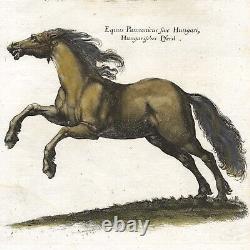
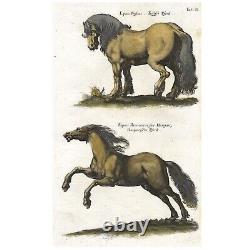
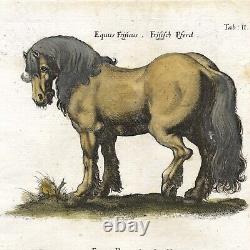
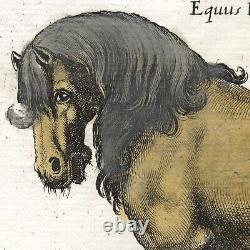
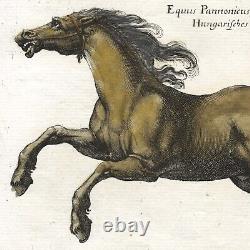
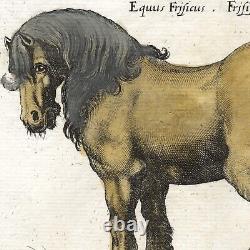

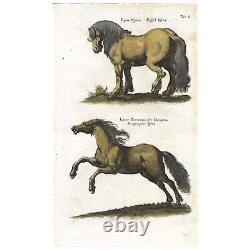



Rare 1655 Hand-Colored Copper-Plate Engraving from. In the middle of the 16th century, the Doctor and Renaissance Man, Johnnes Jonston wrote his magnum opus, an encyclopedic overview of the history of animals, which was considered to be the standard work of zoology for a century.
For his HISTORIAE NATURALIS, Jonston planned a comprehensive illustrated depiction of the world of animals, plants, and people. Titled in short Historia Naturalis Animalium, it collects numerous descriptions of animals in five books. Tables with wonderful copperplate engravings by Matthäus Merian the Younger illustrate the zoological work. In the first volume of the work, which arose in the year 1650, Jonston concerns himself with fish and aquatic mammals. This "most broadly disseminated zoological handbook" experienced numerous republications and translations into other languages, still offering a magnificent and often curious glimpse into the world of zoology today.
The marvelous illustrations, colorfully illustrated moreover, lend the sophisticated publication its final touches and are surely a reason for the exceptional popularity of the Historia Naturalis across Europe. Volume 5, QUADRUPEDIBUS (Quadrupeds), contained 80 numbered plates, called Tables, of which this plate is Tab. Doctor of Medicine and a well-travelled and prolific writer on natural history, who published numerous works, including " Historiae naturalis " in Frankfurt, Germany, from 1646 to 1662. He authored over fifteen works on nature and medicine. The most famous was this one, Historiae naturalis, about the animal kingdom.
It had these gorgeous engravings by Matthaus Merian. The Younger was the half-brother of Maria Sybilla Merian, who is famous for her magnicent Metamorphosis Insectorum Surinamensium of1705, and the brother of Caspar Merian, who also worked on these volumes.
Every part of these prints was made by hand: Hand drawn & engraved on Copper or steel which was hand-mined, smelted & rolled, printed onto handmade cotton rag paper, inked & colored with hand-ground pigments individually by hand, & they were usually hand sewn into handmade leather-bound books. A set of the full volumes of this work.Appears to be in good condition for a centuries-old engraving. The hand-coloring appears to remain sharp & brilliant as the day it was painted. Typical age-toning & character for a print this old. Please peruse the detailed photos. Printed on light Chain-Lined paper with plate-marks.
The hand-coloring appears to be beautifully done. These prints are very old & may have minor imperfections expected with age, such as some typical age-toning of the paper, oxidation of the old original watercolors, spots, text-offsetting, artifacts from having been bound into a book, etc. Please examine the photos & details carefully.
Text Page(s): This one doesn't come with text page(s). Please note, the scans of the title page is included for reference, it's not part of this listing...
The horse (Equus ferus caballus) is a domesticated, one-toed, hoofed mammal. It belongs to the taxonomic family Equidae and is one of two extant subspecies of Equus ferus. The horse has evolved over the past 45 to 55 million years from a small multi-toed creature, close to Eohippus, into the large, single-toed animal of today.
Humans began domesticating horses around 4000 BCE, and their domestication is believed to have been widespread by 3000 BCE. Horses are adapted to run, allowing them to quickly escape predators, and possess an excellent sense of balance and a strong fight-or-flight response. Horses are considered to be one of the most intelligent animals on earth, due to their ability to learn quickly and remember things for a long time. They can also solve problems and figure out how to get what they want. They are able to learn complex tasks quickly and remember them for a long time. They are also well-known social animals and are able to form strong bonds with their humans and other horses. Size: 13" x 7-1/2" inches approximately.If you'd like to combine & need more time to choose, please send a message & we'll do our best to oblige.

